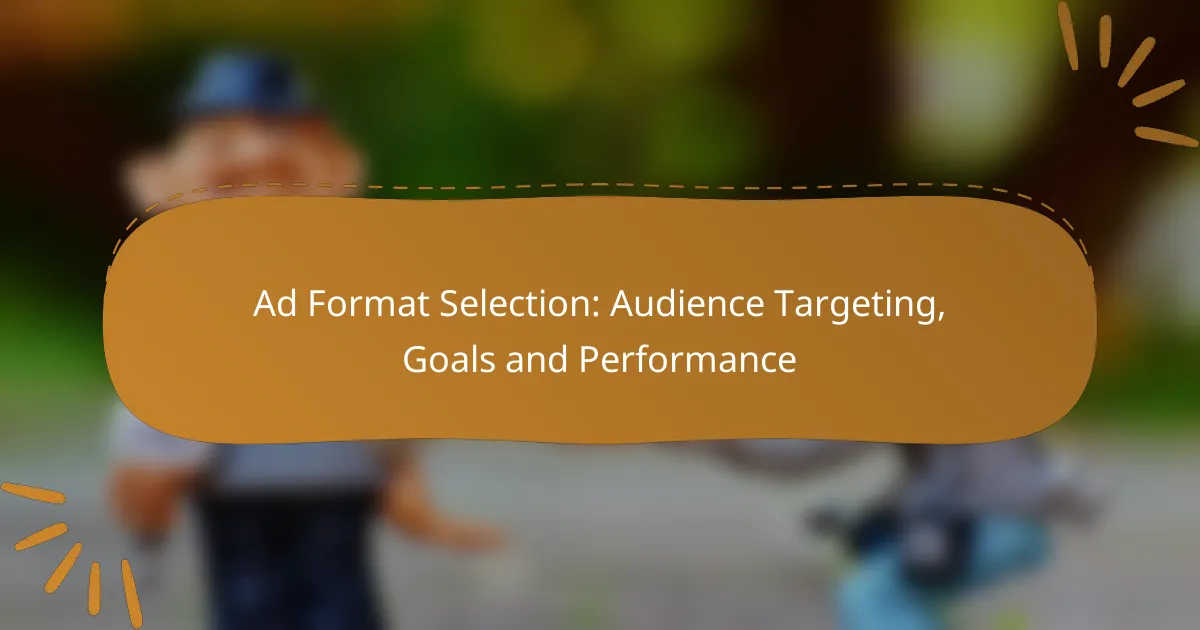Selecting the appropriate ad format is vital for successful display advertising, as it hinges on a deep understanding of your target audience, campaign objectives, and performance metrics. By aligning these elements, advertisers can enhance engagement and conversion rates, ensuring their messages resonate with the right viewers. Tailored strategies for audience targeting and specific marketing goals further refine ad format selection, maximizing overall effectiveness.

How to select the right ad format for display advertising?
Selecting the right ad format for display advertising involves understanding your target audience, aligning with your campaign goals, and evaluating performance metrics. The right choice can significantly enhance engagement and conversion rates, making it essential to consider these factors carefully.
Consider audience preferences
Understanding audience preferences is crucial when selecting an ad format. Different demographics respond better to specific formats; for instance, younger audiences may prefer video ads, while older groups might engage more with static images. Conducting surveys or analyzing past campaign data can provide insights into what formats resonate best with your target market.
Additionally, consider the platforms your audience frequents. For example, social media platforms often favor visually appealing formats, while websites may benefit from more informative banner ads. Tailoring your ad format to the preferences of your audience can lead to higher engagement rates.
Align with campaign goals
Your campaign goals should directly influence the ad format you choose. If your objective is brand awareness, visually striking formats like rich media or video ads can capture attention effectively. Conversely, if your goal is to drive conversions, formats that include clear calls to action, such as clickable banners or lead generation forms, may be more appropriate.
Consider the stage of the customer journey as well. For top-of-funnel awareness, broader formats work well, while bottom-of-funnel tactics may require more direct and actionable formats. Aligning your ad format with specific goals ensures that your advertising efforts are focused and effective.
Evaluate performance metrics
Evaluating performance metrics is essential to determine the effectiveness of your chosen ad format. Key metrics to consider include click-through rates (CTR), conversion rates, and engagement levels. Analyzing these metrics can help you identify which formats are performing well and which may need adjustments.
Use A/B testing to compare different ad formats against each other. This method allows you to gather data on how each format performs under similar conditions, providing a clearer picture of what works best for your audience and goals. Regularly reviewing these metrics ensures that your advertising strategy remains agile and responsive to performance trends.

What audience targeting strategies enhance ad format selection?
Effective audience targeting strategies significantly enhance ad format selection by ensuring that advertisements reach the most relevant viewers. By understanding the audience’s characteristics, behaviors, and contexts, advertisers can choose formats that resonate better and drive performance.
Demographic targeting
Demographic targeting involves selecting audiences based on specific characteristics such as age, gender, income level, and education. This strategy allows advertisers to tailor their messages to align with the preferences and needs of different demographic groups. For instance, a luxury brand may focus on high-income individuals aged 30-50, while a toy company might target parents with young children.
When implementing demographic targeting, consider using data from surveys, social media insights, or market research. This information can help refine your audience segments and improve ad relevance. However, avoid overly narrow targeting, as it may limit reach and reduce potential engagement.
Behavioral targeting
Behavioral targeting focuses on users’ online behaviors, such as their browsing history, purchase patterns, and interactions with previous ads. By analyzing these behaviors, advertisers can create more personalized ad experiences that are likely to convert. For example, if a user frequently visits travel websites, they may be shown ads for vacation packages or travel gear.
To effectively implement behavioral targeting, utilize tracking tools and analytics platforms to gather data on user interactions. Keep in mind that privacy regulations, such as GDPR in Europe, may require transparency and user consent for data collection. Balancing personalization with privacy is crucial for maintaining trust and compliance.
Contextual targeting
Contextual targeting places ads based on the content of the webpage or platform where they appear. This strategy ensures that ads are relevant to the surrounding content, increasing the likelihood of engagement. For example, an ad for running shoes may be displayed on a fitness blog or a sports news site.
When using contextual targeting, focus on selecting keywords and topics that align with your product or service. This method can be particularly effective for brand awareness campaigns, as it creates a seamless experience for users. However, be cautious of ad placements on inappropriate or unrelated content, as this can harm brand perception.

What are the key goals for choosing ad formats?
Choosing ad formats is crucial for achieving specific marketing objectives. The primary goals include increasing brand awareness, driving website traffic, and boosting conversions, each requiring tailored strategies and ad types to maximize effectiveness.
Increase brand awareness
Increasing brand awareness involves making potential customers familiar with your brand and its offerings. Effective ad formats for this goal include display ads, video ads, and social media promotions that emphasize visual storytelling and brand identity.
Consider using high-impact visuals and engaging content to capture attention. For instance, video ads on platforms like YouTube can reach a wide audience, while social media stories can create a more personal connection with viewers.
Drive website traffic
Driving website traffic focuses on directing users to your site for further engagement. Ad formats such as search ads, sponsored content, and banner ads are effective in encouraging clicks and visits.
Utilize clear calls-to-action (CTAs) and compelling headlines to entice users. For example, search ads on Google can target specific keywords, ensuring your ads appear when potential customers are actively searching for related products or services.
Boost conversions
Boosting conversions aims to turn visitors into customers through effective ad strategies. Formats like retargeting ads, lead generation forms, and product listings can significantly enhance conversion rates.
Focus on personalized messaging and offers that resonate with your audience. For instance, retargeting ads can remind users of products they viewed, encouraging them to complete their purchase. Ensure your landing pages are optimized for a seamless user experience to maximize conversion potential.

How do different ad formats perform in display advertising?
Different ad formats in display advertising can significantly impact campaign performance based on audience engagement and conversion goals. Understanding how each format performs helps advertisers choose the right approach to maximize effectiveness and return on investment.
Banner ads performance
Banner ads are one of the most common formats in display advertising, typically featuring static or animated images. Their performance often hinges on placement and design; well-placed banners can achieve click-through rates (CTR) in the low single digits, while poorly designed ones may struggle to engage users.
To enhance effectiveness, ensure that banner ads are visually appealing and include a clear call to action. A/B testing different designs and placements can help identify what resonates best with your target audience.
Video ads performance
Video ads tend to have higher engagement rates compared to static formats, often achieving CTRs in the mid to high single digits. They can convey more information and evoke emotions, making them effective for storytelling and brand awareness.
However, video ads require careful consideration of length and content. Shorter videos, typically under 30 seconds, are more likely to retain viewer attention. Platforms like YouTube or social media channels can provide valuable insights into viewer behavior and preferences.
Native ads performance
Native ads blend seamlessly with the content of the platform, making them less intrusive and often leading to higher engagement rates. They can achieve CTRs that are significantly higher than traditional display ads, sometimes reaching double digits.
To maximize the performance of native ads, ensure that the content aligns with the surrounding material and provides genuine value to the audience. Monitoring performance metrics and adjusting the content based on user feedback can enhance effectiveness over time.

What criteria should be considered for ad format selection?
When selecting an ad format, consider factors such as audience targeting, campaign goals, and performance metrics. These criteria help ensure that the chosen format aligns with your marketing objectives and effectively reaches your intended audience.
Ad placement options
Ad placement options refer to where your ads will appear, which can significantly impact their effectiveness. Common placements include social media feeds, search engine results, and websites. Each option has its own audience and engagement levels, so choose placements that align with your target demographic.
For instance, ads on social media platforms may yield higher engagement rates among younger audiences, while search ads might be more effective for capturing intent-driven users. Evaluate the strengths of each placement to maximize visibility and interaction.
Cost-effectiveness
Cost-effectiveness is crucial when selecting an ad format, as it determines the return on investment (ROI) for your campaigns. Different formats come with varying costs, such as pay-per-click (PPC) for search ads or cost-per-impression (CPM) for display ads. Assess your budget and expected performance to find the most economical option.
For example, if your goal is brand awareness, CPM might be more suitable, while PPC could be better for driving conversions. Always compare the potential reach and engagement against the costs to ensure you are making a financially sound decision.
Creative flexibility
Creative flexibility involves the ability to customize your ads to fit your brand’s message and aesthetic. Some formats allow for rich media, such as videos and interactive elements, while others may be more limited. Consider how much creative control you need to effectively communicate your message.
For instance, video ads can convey complex stories and emotions, making them ideal for brand storytelling. In contrast, static image ads may be more straightforward but could lack the engagement of dynamic formats. Choose a format that allows you to express your brand identity while meeting your campaign goals.

What are the emerging trends in ad format selection?
Emerging trends in ad format selection focus on enhancing audience engagement and optimizing performance across various platforms. Advertisers are increasingly adopting formats that leverage interactivity, personalization, and data-driven insights to achieve their marketing goals.
Interactive Ad Formats
Interactive ad formats, such as polls, quizzes, and augmented reality experiences, are gaining traction as they foster user engagement. These formats encourage users to participate actively rather than passively consuming content, leading to higher retention rates and brand recall.
When selecting interactive formats, consider the target audience’s preferences and the platform’s capabilities. For instance, social media platforms like Instagram and TikTok are well-suited for short, engaging interactive ads that capture attention quickly.
Personalization in Ad Delivery
Personalization is becoming a cornerstone of effective ad strategies, allowing brands to tailor messages based on user behavior and preferences. By utilizing data analytics, advertisers can create targeted campaigns that resonate with specific audience segments, improving conversion rates.
To implement personalization, leverage customer data to segment your audience and craft tailored messages. For example, an e-commerce brand might show different product ads to users based on their browsing history, enhancing relevance and engagement.
Video Content Dominance
Video content continues to dominate ad formats, driven by its ability to convey messages quickly and effectively. Short-form videos, in particular, are popular on platforms like YouTube and TikTok, where users prefer quick, digestible content.
When incorporating video into your ad strategy, aim for concise, impactful storytelling. Keep videos under 30 seconds to maintain viewer interest, and ensure that key messages are delivered within the first few seconds to capture attention.
Mobile-First Approach
As mobile usage increases, adopting a mobile-first approach in ad format selection is essential. Ads designed specifically for mobile devices tend to perform better due to their optimized layouts and user experience.
Ensure that your ad formats are responsive and visually appealing on smaller screens. Test different formats, such as vertical videos or carousel ads, to determine what resonates best with your mobile audience.
